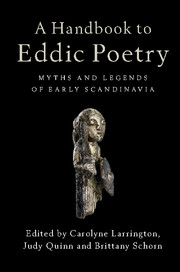Book contents
- Frontmatter
- Contents
- List of illustrations
- List of contributors
- Translations and abbreviations of the titles of eddic poems
- Introduction
- 1 The transmission and preservation of eddic poetry
- 2 Traditions of eddic scholarship
- 3 The editing of eddic poetry
- 4 The dating of eddic poetry
- 5 Eddic performance and eddic audiences
- 6 Eddic poetry and mythology
- 7 Eddic poetry and the religion of pre-Christian Scandinavia
- 8 Eddic poetry and heroic legend
- 9 Place names in eddic poetry
- 10 Eddic poetry and the imagery of stone monuments
- 11 Eddic poetry and archaeology
- 12 Eddic modes and genres
- 13 Eddic metres
- 14 Eddic style
- 15 Kennings and other forms of figurative language in eddic poetry
- 16 Alliterative lexical collocations in eddic poetry
- 17 The representation of gender in eddic poetry
- 18 The reception of eddic poetry
- Consolidated bibliography
- Index
10 - Eddic poetry and the imagery of stone monuments
Published online by Cambridge University Press: 05 August 2016
- Frontmatter
- Contents
- List of illustrations
- List of contributors
- Translations and abbreviations of the titles of eddic poems
- Introduction
- 1 The transmission and preservation of eddic poetry
- 2 Traditions of eddic scholarship
- 3 The editing of eddic poetry
- 4 The dating of eddic poetry
- 5 Eddic performance and eddic audiences
- 6 Eddic poetry and mythology
- 7 Eddic poetry and the religion of pre-Christian Scandinavia
- 8 Eddic poetry and heroic legend
- 9 Place names in eddic poetry
- 10 Eddic poetry and the imagery of stone monuments
- 11 Eddic poetry and archaeology
- 12 Eddic modes and genres
- 13 Eddic metres
- 14 Eddic style
- 15 Kennings and other forms of figurative language in eddic poetry
- 16 Alliterative lexical collocations in eddic poetry
- 17 The representation of gender in eddic poetry
- 18 The reception of eddic poetry
- Consolidated bibliography
- Index
Summary
Many myths and legends preserved in eddic poetry had likely circulated in various artistic media long before they were shaped into the poetic forms that have come down to us in the Codex Regius collection of eddic poems (GKS 2365 4°; c.1270) and other manuscripts. It is unclear, however, how widely disseminated these stories were, geographically and chronologically, and their earlier narrative forms are equally beyond our reach. The date and place of composition of the surviving eddic poems themselves are often contested (see Thorvaldsen, Chapter 4 in this Handbook). In most cases the poems can only point to late attestations of the pagan myths and heroic legends, some of them influenced by Christianity.
Figural representations in the art of the pre-Viking and Viking periods and the corpus of skaldic poetry provide us with evidence for the early development, transformation, and dissemination of the narratives that found their way into the eddic corpus. These sources usually predate the eddic poems, and the early attestations of stories are sometimes at variance with the eddic poems as well as with Snorri Sturluson's Edda (c.1220), which offers the most detailed and coherent versions of many of these stories (see Schjødt, Chapter 7 in this Handbook). The situation is further complicated by the fact that neither skaldic poetry nor the visual art of early medieval Northern Europe are narrative art forms. They do contain references, of varying degrees of transparency, to myths, deities, and heroic figures, but in most cases without much narrative detail. Nonetheless, the evidence they provide is invaluable for understanding where and when particular mythological or heroic figures were known, in what artistic and cultural (and, by implication, social) contexts, and which elements of their stories were considered most significant and worthy of recording.
It is the varied corpus of carved stone monuments that provides the richest surviving evidence for visual representations of mythological and heroic narratives in the art of the Viking Age. There are three groups of stone monuments that are of special relevance in this context: picture stones from the island of Gotland in the Baltic Sea, runestones with pictorial representations from Scandinavia, and early medieval sculpture from the British Isles.
- Type
- Chapter
- Information
- A Handbook to Eddic PoetryMyths and Legends of Early Scandinavia, pp. 190 - 211Publisher: Cambridge University PressPrint publication year: 2016
- 3
- Cited by



